Initial Steps of Neonatal Resuscitation with the Nonvigorous and Preterm Infant
Initial Steps of Neonatal Resuscitation with the Nonvigorous and Preterm Infant
Supporting the Baby’s Temperature
Studies show that the newly born infant’s inability to maintain a normal temperature corresponds to a high risk of mortality. Preterm infants are particularly poor at maintaining a normal temperature, and thus they are very vulnerable to this mortality risk.6
A newborn with hypothermia is at increased risk for intraventricular hemorrhage (IVH), late-onset sepsis, hypoglycemia, and respiratory problems. The hospital must implement protocols to ensure the strict measurement and maintenance of normothermia in the newborn. The ideal temperature is between 36.5 and 37.5°C.
For preterm infants, polyethylene plastic wrap supports normal temperature maintenance. Skin-to-skin contact, often called kangaroo care, can suffice for term infants.
Essential techniques to support a normal body temperature in the newly born:
- Increase the temperature in the infant’s room
- Provide skin-to-skin contact
- Place the baby on a thermal mattress
- Warm and humidify resuscitation gas
- Wrap the preterm infant in polyethylene plastic wrap
- Place the baby under a radiant warmer
- Place a cap on the infant’s head
When rewarming a newborn, a slow but gradual increase in temperature is recommended. Rapid rewarming can cause apnea and arrhythmias. The team should increase the temperature by 0.5°C per hour.
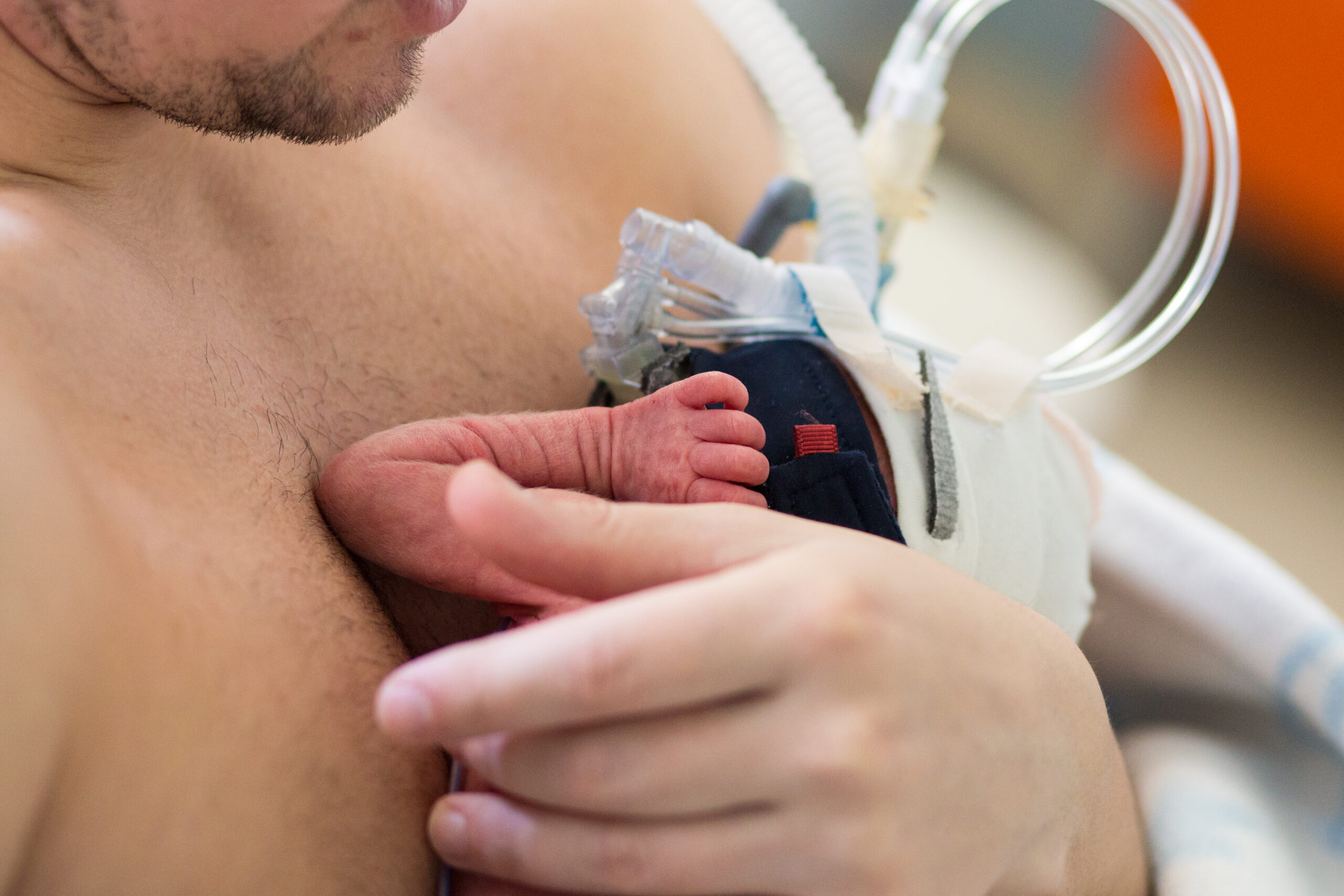
Kangaroo care.
It is also vital to avoid hyperthermia (> 38.0°C) because it is associated with increased morbidity and mortality. Maternal fever during labor can cause seizures and encephalopathy in the newly born and also poses a risk of mortality. On the other hand, maternal hypothermia during labor does not seem to cause a problem for the fetus or affect neonatal outcomes during delivery.
Opening the Airway
Opening the newly born’s airway requires repositioning the head and neck. The infant is placed supine on the radiant warmer with the head and neck in a neutral but slightly extended position, known as the sniffing position. Hyperextension or flexion of the neck may cause a restriction in airflow.
A rolled-up towel may be placed underneath the infant’s shoulders to maintain the correct position. This technique is particularly useful in the newly born with caput succedaneum or an elongated occiput.
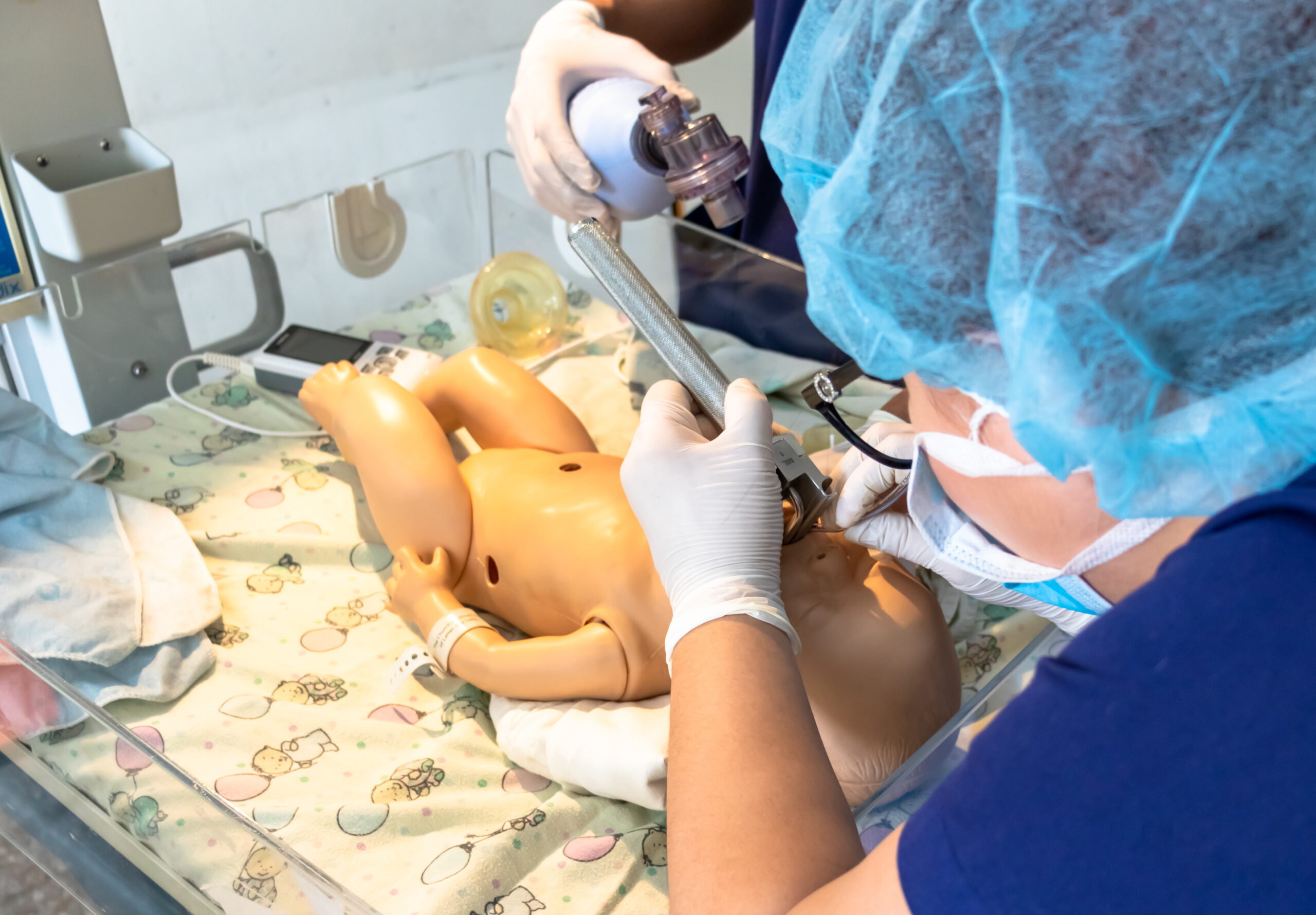
Sniffing position during intubation. Note the rolled-up towel placed underneath the infant’s shoulders.
Clearing the Airway
Suctioning Clear Amniotic Fluid
The newly born should be suctioned when mucus or fluid obstructs the airway and before initiating positive pressure ventilation (PPV). Suctioning may induce bradycardia secondary to stimulation of the vagus nerve. Likewise, tracheal suctioning in intubated infants poses a risk for deterioration of pulmonary compliance and cerebral blood flow fluctuations.
Suctioning with Meconium Present
Meconium is an indicator of fetal distress and increases the likelihood of morbidity and mortality in the newly born and that the baby will require resuscitation. The neonatal resuscitation team must be ready and present during the birth of this high-risk infant. At least one member of the team must be adept at endotracheal intubation.
Key Takeaway
When suctioning meconium-stained fluid, first suction from the mouth and then from the nose.
Mnemonic: M(outh) before N(ose)
If the baby is vigorous with good respiratory activity and muscle tone, just a gentle clearing of meconium from the mouth and then the nose with a bulb syringe is required.
After clearing the secretions, the baby can receive routine care.
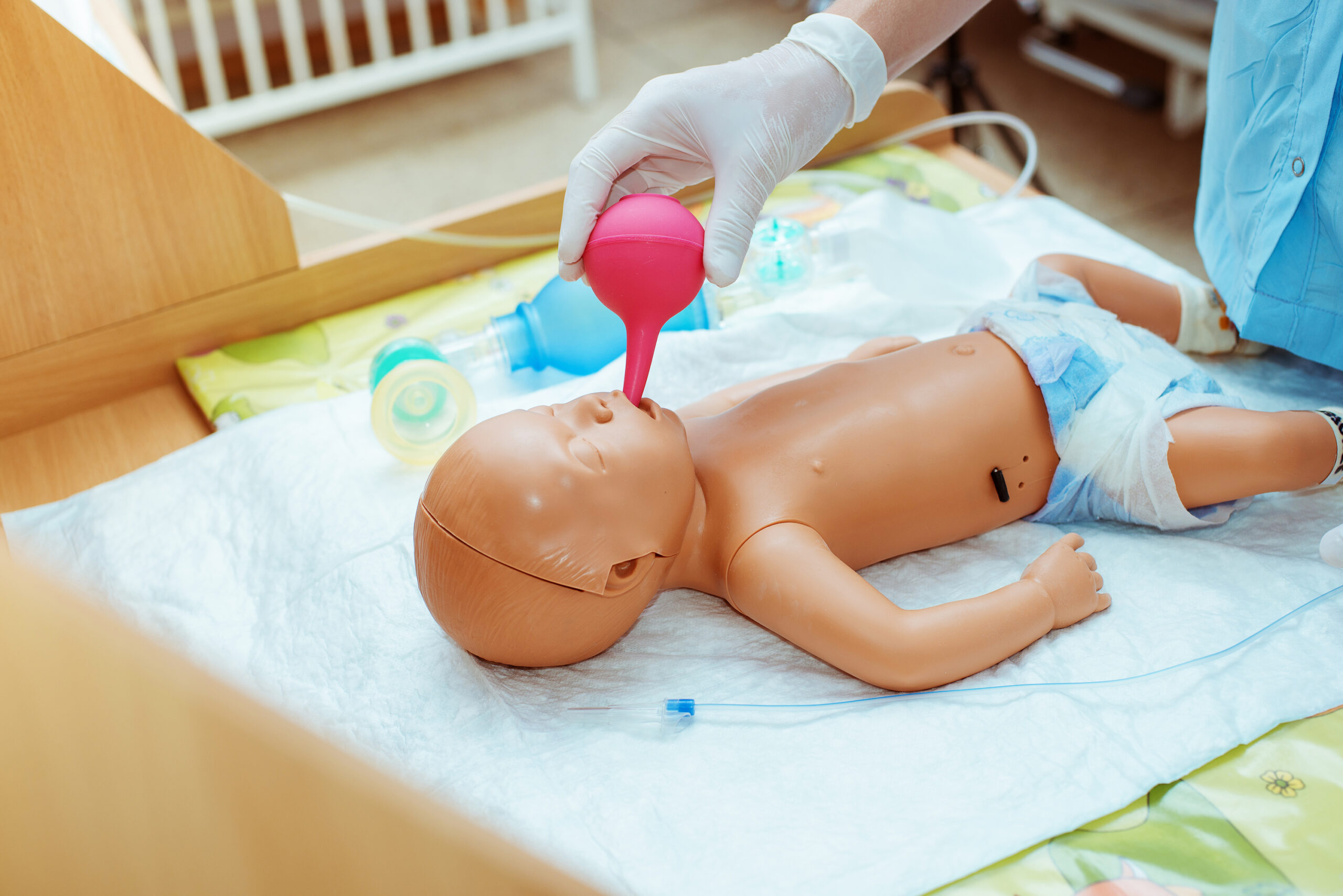
Using a bulb syringe to suction the meconium.
If the newly born is in distress with poor respiratory effort and muscle tone, the initial steps for resuscitation should begin. The team places the infant in the radiant warmer and proceeds to dry and stimulate. PPV is indicated for infants with bradycardia (heart rate < 100 bpm) or apnea.
Studies show that routine intubation for tracheal suctioning is not needed.7 Instead, the team should practice the fundamentals of neonatal resuscitation and not delay in providing bag-mask ventilation.
Key Takeaway
Routine intubation for tracheal suctioning is no longer suggested.
If needed, ventilation should begin within the first minute of life, but if an airway obstruction is present, the team should consider intubation and suction.
Drying
Wet skin significantly lowers the temperature of the newly born. Due to the secretions and fluids, evaporative heat loss plays a significant role. The infant must be dried with a warm, dry towel or blanket. Once the towel or blanket becomes wet, it should be exchanged. If a newly born is very preterm (< 32 weeks gestation), the infant is wrapped in polyethylene plastic rather than dried.
Drying and clearing the airway can occur simultaneously through the coordinated efforts of team members. Stimulating, opening the airway, suctioning, and drying are often enough to prompt the newly born to breathe. Once these initial interventions are complete, the team can gently rub the back, trunk, and extremities if the newly born continues to have inadequate respiration. Shaking should never be used as it is not a safe method of stimulation.
Infants who have experienced a short period of impaired gas exchange often respond to stimulation and begin to breathe spontaneously. However, if the infant’s gas exchange has been disrupted for a significant amount of time, PPV is required. Hence, the team should spend only a brief time attempting stimulation and begin PPV if the infant remains apneic.
Assessing the Initial Steps
Evaluating Respirations and Oxygenation
Respirations and oxygenation are important clinical indicators of the baby’s status. A crying baby has good respiratory effort. A baby who is gasping or completely apneic needs PPV immediately. When PPV begins, the team member must assess the heart rate.
Oxygen saturation is a useful indicator of adequate gas exchange. However, oxyhemoglobin remains below extrauterine values for up to 10 minutes following birth. Cyanosis can be a normal finding during this time, so observing skin color is a poor indicator of oxygen saturation during the immediate neonatal period.
Hypoxia and hyperoxia are harmful to the newborn. Hypoxia can result in tissue ischemia causing multiorgan injuries. Excessive oxygen delivery is linked to an increased risk of morbidity and mortality. Therefore, the use of a pulse oximeter is necessary. The pulse oximeter assists in determining whether supplementary oxygen is needed and, if so, how much is required.
When the baby has labored breathing, is cyanotic, or requires PPV, one team member attaches a pulse oximeter to the newly born. The oximeter probe must be placed on a preductal circulation point, such as the right upper extremity. The medial surface of the infant’s right palm or wrist is a good place for the probe.
Evaluating Heart Rate
The most sensitive indicator of a successful response to intervention is the heart rate. An increase in heart rate while performing a resuscitation intervention indicates that the action is effective. The heart rate can be assessed with a stethoscope or by palpating the pulse at the umbilical cord base. The pulse oximeter also measures heart rate. However, in a baby with poor perfusion or poor cardiac output, the pulse oximeter may be unreliable.
Key Takeaway
The heart rate is the best indicator of successful intervention during resuscitation.
A 3-lead ECG records the most rapid and accurate measurement of the heart rate. ECG monitoring should be considered if PPV is required and implemented as soon as the team recognizes the need for an alternative airway.
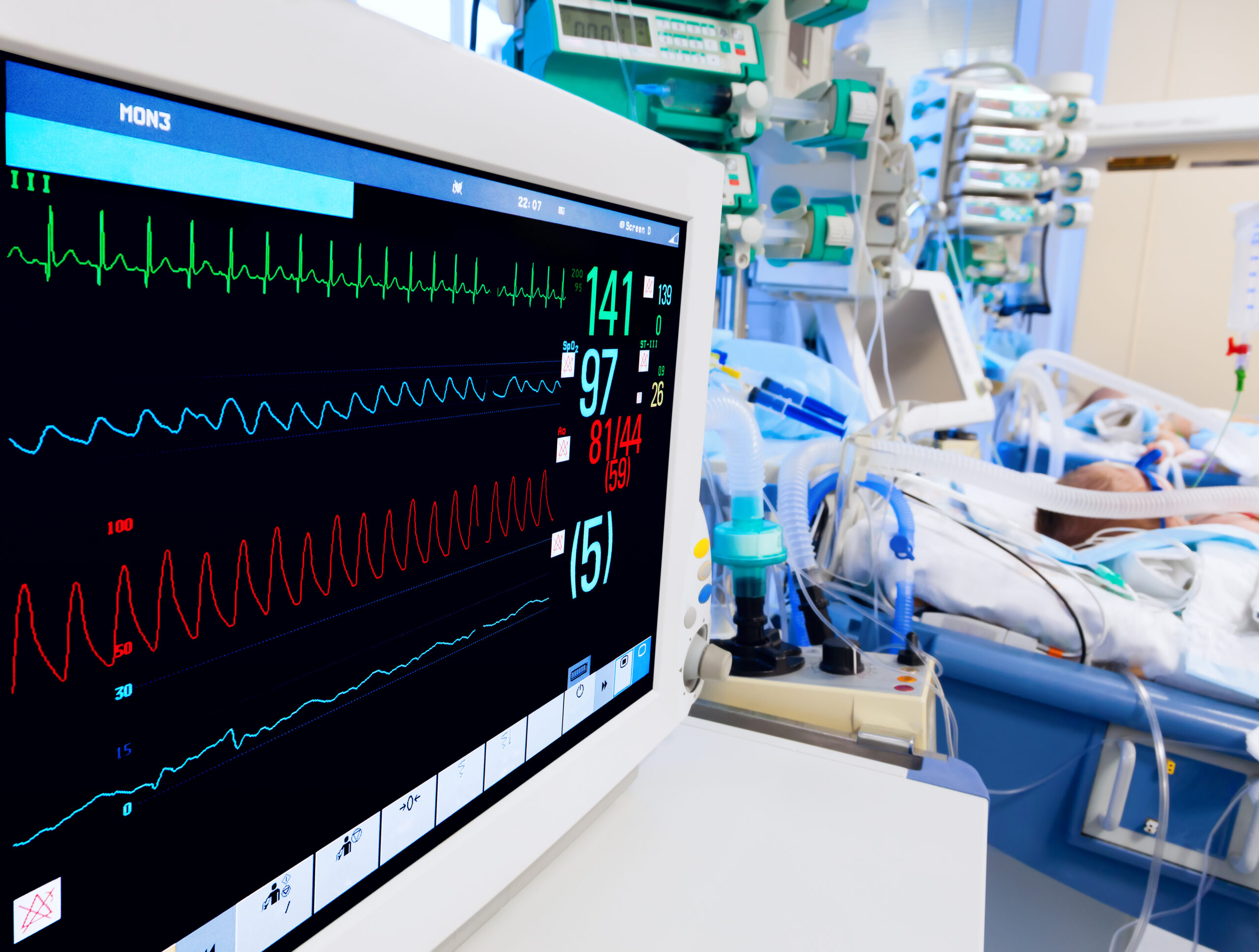
Infant on an ECG monitor.
Persistent Cyanosis
Cyanosis is a bluish discoloration of the skin, denoting poor oxyhemoglobin concentration. However, assessing oxygenation by observing skin color is not a good indicator of the infant’s overall oxyhemoglobin status.
Sometimes, the infant may have acrocyanosis, cyanosis of the hands and feet. Acrocyanosis in the newly born is not necessarily an indication of poor oxygen saturation. Healthy babies may also present upon delivery with cyanosis for several minutes, after which the baby should have a pinkish color. Central cyanosis presents with bluish discoloration of the baby’s lips, tongue, and torso.
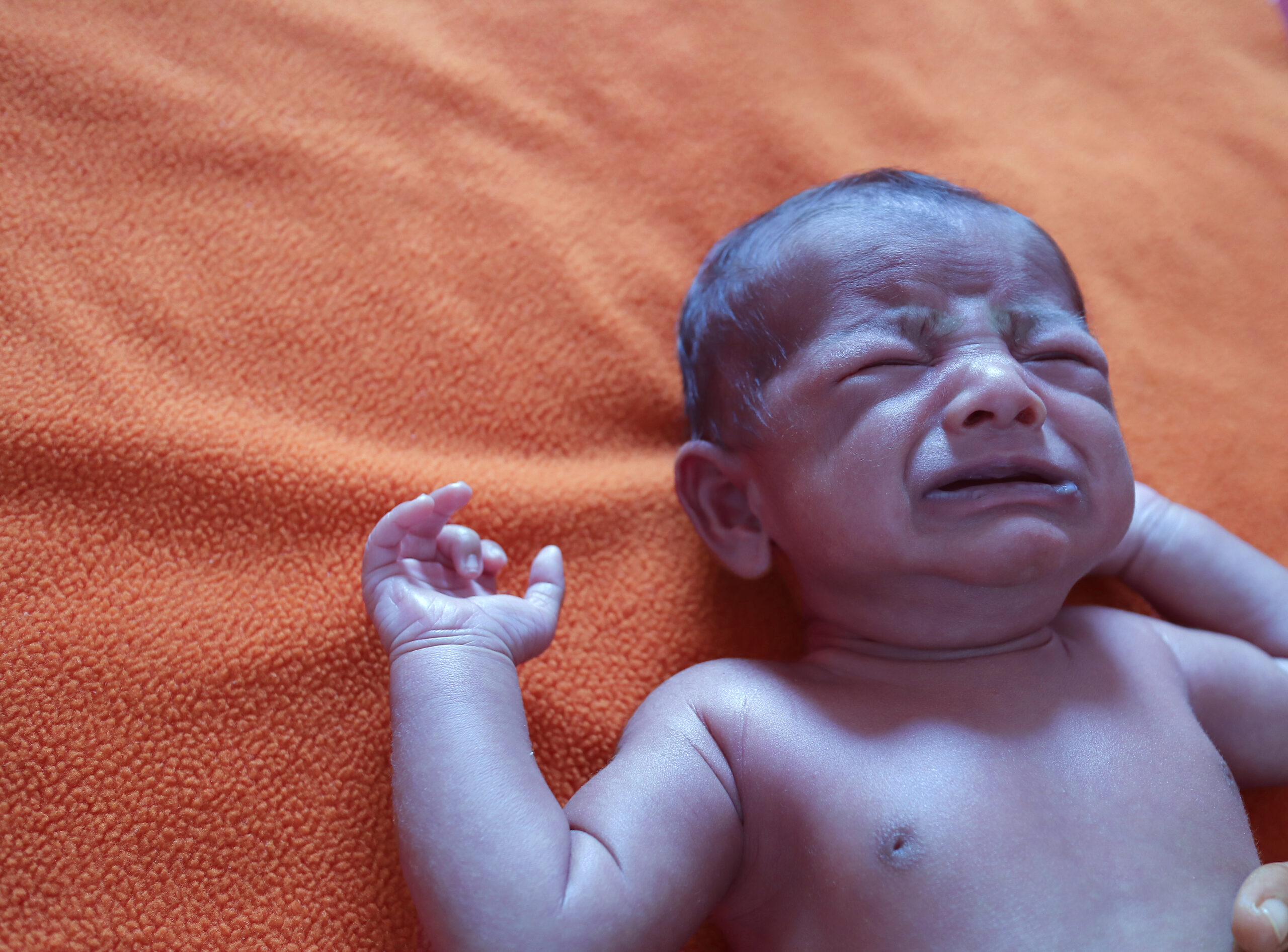
If central cyanosis is persistent, use the pulse oximeter to evaluate oxygen saturation.
6 Laptook AR, Bell EF, Shankaran S, et al. Admission temperature and associated mortality and morbidity among moderately and extremely preterm infants. J Pediatr. 2018;192:53–59.e2.
7 Foster JP, Dawson JA, Davis PG, Dahlen HG. Routine oro/nasopharyngeal suction versus no suction at birth. Cochrane Database Syst Rev. 2017;4(4):CD010332.
https://www.cochranelibrary.com/cdsr/doi/10.1002/14651858.CD010332.pub2/full